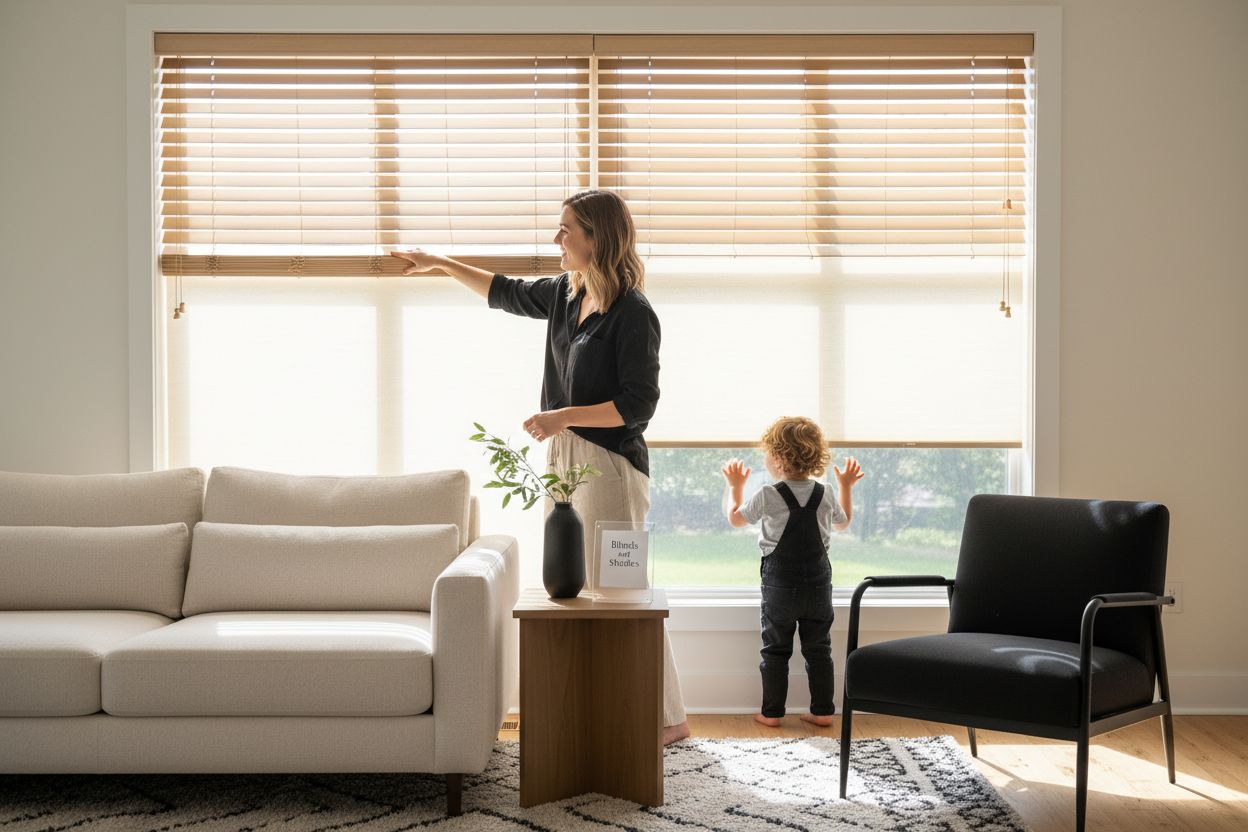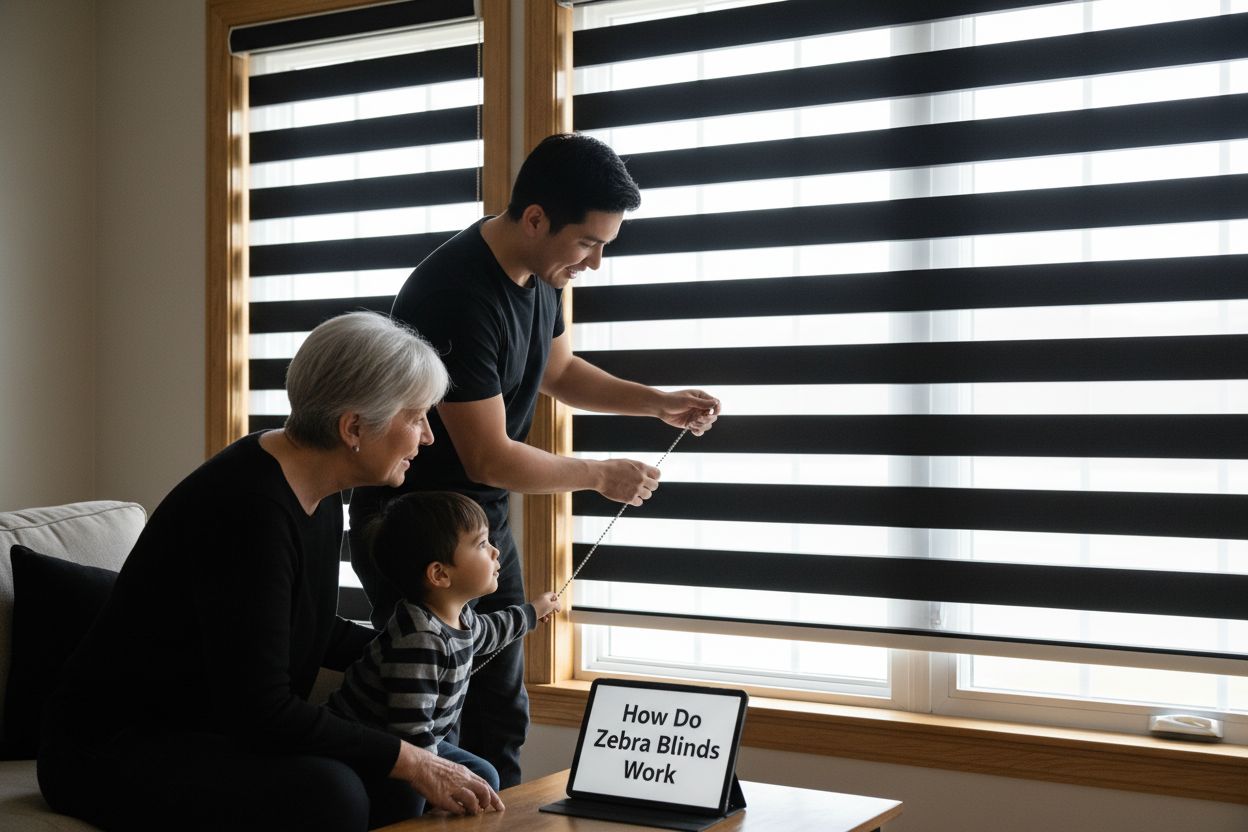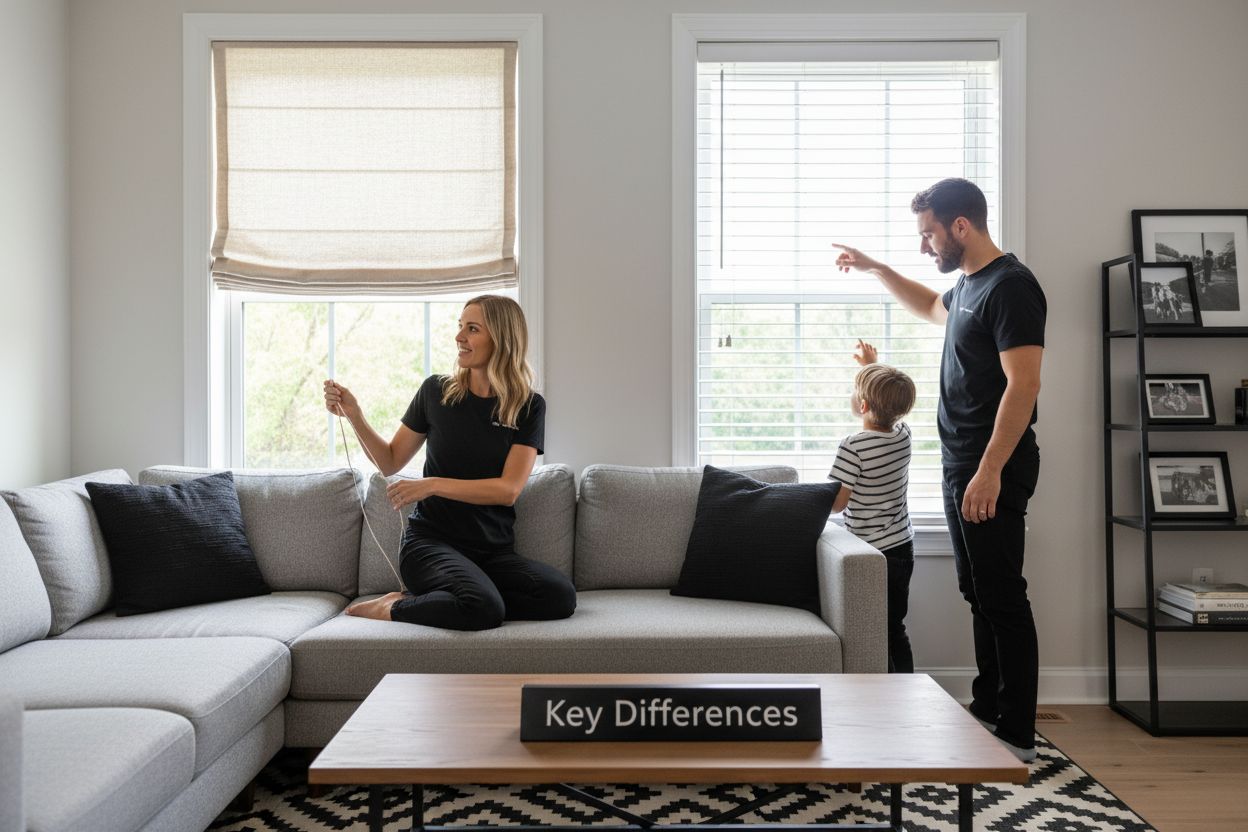
Understanding Roman Shades vs Blinds: Key Differences
Picking the right window treatment can totally change how your space looks and feels. Some people think it is just about blocking light or adding a splash of color. Yet proper window treatments can actually cut your heating and cooling costs by up to 25 percent, making a real impact on your comfort and your wallet. Which means those fabric shades or sleek blinds you choose hold a lot more power than most realize.
Table of Contents
- Defining Roman Shades And Blinds: Key Features
- The Importance Of Choosing The Right Window Treatment
- Comparative Analysis: Benefits Of Roman Shades Vs Blinds
- Aesthetic And Functional Considerations In Window Coverings
- Material Choices And Customization Options
Quick Summary
| Takeaway | Explanation |
|---|---|
| Choose Roman Shades for Soft Aesthetics | Roman shades offer a continuous fabric look that enhances warmth and texture in your space. |
| Opt for Blinds for Light Control | Blinds provide adjustable slats for precise light management and privacy enhancement. |
| Consider Energy Efficiency When Selecting | Proper window treatments can reduce heating and cooling costs by up to 25% through improved insulation. |
| Match Window Treatments to Design Style | Ensure your window coverings complement the room’s decor for visual harmony and consistency. |
| Explore Customization Options for Personalization | Tailor materials and styles to fit your aesthetic vision and functional needs, enhancing practicality and design. |
Defining Roman Shades and Blinds: Key Features
Window treatments play a crucial role in transforming interior spaces, with roman shades and blinds being two popular options that offer distinct aesthetic and functional benefits. Understanding their key characteristics helps homeowners make informed design decisions.
What Are Roman Shades?
Roman shades are elegant window coverings crafted from soft fabric that fold neatly into horizontal pleats when raised. Discover more about window treatment styles reveals that these shades provide a smooth, streamlined appearance that blends sophistication with practicality. Unlike traditional blinds, roman shades create a soft, continuous fabric surface that adds texture and warmth to interior spaces.
Key characteristics of roman shades include:
- Fabric construction that offers excellent light filtering capabilities
- Versatile design options ranging from lightweight sheers to heavy blackout materials
- Ability to complement various interior design styles from modern minimalist to traditional
Understanding Window Blinds
Blinds represent a more structured window covering featuring horizontal or vertical slats made from materials like wood, aluminum, or plastic. These window treatments excel in providing precise light control through adjustable slats that can be tilted to manage sunlight and privacy levels.
Distinctive features of blinds include:
- Precise angle-based light management
- Durable materials suitable for different environmental conditions
- Wide range of opacity levels from sheer to completely opaque
While both roman shades and blinds serve essential functions in home design, they differ significantly in their visual impact and operational mechanics. Roman shades offer a softer, more continuous aesthetic, whereas blinds provide a more geometric, structured appearance. Your choice ultimately depends on your specific design preferences, light control needs, and the overall ambiance you wish to create in your living spaces.
The following table compares the key features, benefits, and considerations of roman shades and blinds to help readers decide which option best matches their needs.
| Feature / Factor | Roman Shades | Blinds |
|---|---|---|
| Appearance | Soft, continuous fabric surface | Structured look with horizontal or vertical slats |
| Material Options | Wide variety of fabric types and patterns | Wood, aluminum, plastic, and composite materials |
| Light Control | Graduated filtering, depends on fabric weight | Precise control via adjustable slats |
| Energy Efficiency | Provides strong insulation, helps regulate temperature | Moderate insulation, varies by material |
| Privacy | Enhanced privacy due to seamless construction | Privacy can be limited by gaps between slats |
| Maintenance | May require more care, depends on fabric | Generally easier to clean and maintain |
| Customization | Highly customizable: fabrics, trims, folding styles | Variety in materials, finishes, slat width, operation |
For those interested in exploring more detailed insights into window treatment options, our comprehensive guides can help you make an informed decision tailored to your home’s unique requirements.
The Importance of Choosing the Right Window Treatment
Selecting the perfect window treatment goes beyond mere aesthetic considerations, representing a strategic decision that impacts comfort, energy efficiency, and overall home functionality. The right window covering can transform a space, providing practical benefits while reflecting personal style and design sensibilities.
Energy Efficiency and Comfort
Research from the U.S. Department of Energy demonstrates that thoughtfully selected window treatments can significantly reduce energy consumption. Window coverings act as thermal barriers, helping regulate indoor temperatures by minimizing heat gain during summer and reducing heat loss in winter. Proper window treatments can potentially decrease heating and cooling costs by up to 25%, making them an essential consideration for environmentally conscious and budget-minded homeowners.
Key energy efficiency considerations include:
- Selecting materials with high insulation properties
- Choosing treatments that create an additional barrier against temperature fluctuations
- Understanding how different window coverings impact solar heat gain
Aesthetic and Functional Transformations
Beyond energy savings, window treatments play a crucial role in defining interior spaces. They offer multiple functional benefits, including:
- Light control and privacy management
- Sound insulation
- Protection of furniture and flooring from UV damage
- Enhancement of architectural features
Your window treatment choice can dramatically alter a room’s ambiance, creating softer, more inviting spaces or establishing clean, modern aesthetics. Explore our guide on custom window treatments to understand how strategic selections can elevate your home’s design.
Ultimately, window treatments represent an intersection of form and function. Whether you prioritize energy efficiency, design flexibility, or practical light management, the right choice can significantly enhance your living environment, providing comfort, style, and long-term value for your home.
Comparative Analysis: Benefits of Roman Shades vs Blinds
Selecting between roman shades and blinds involves understanding their unique advantages and potential drawbacks. Each window treatment offers distinct characteristics that cater to different aesthetic preferences, functional requirements, and interior design goals.
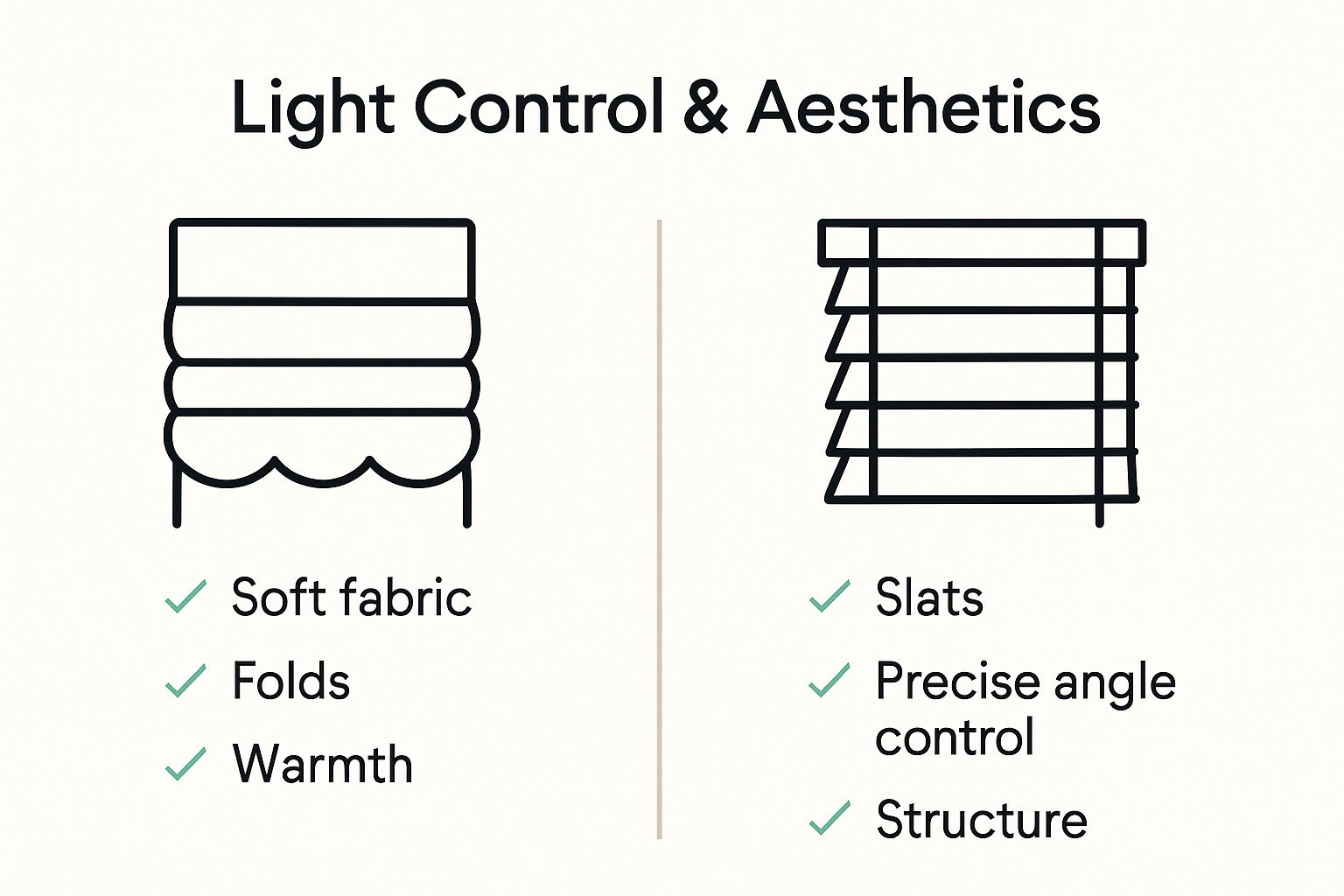
Light Control and Aesthetics
Interior design experts from Houzz highlight the fundamental differences between roman shades and blinds in managing light and visual appeal. Roman shades excel in creating a soft, continuous fabric surface that introduces texture and warmth, while blinds provide more precise light manipulation through adjustable horizontal or vertical slats.
Key light control characteristics include:
- Roman shades offering graduated light filtering based on fabric weight
- Blinds enabling exact angle-based sunlight management
- Ability to create different ambiances through material and design choices
Practical Performance Considerations
Beyond aesthetic appeal, performance metrics differentiate these window treatments. Roman shades typically provide superior insulation due to their continuous fabric construction, potentially reducing energy costs. Blinds, conversely, offer more robust durability and easier maintenance, particularly in high humidity environments.
Critical performance factors encompass:
- Thermal efficiency and potential energy savings
- Maintenance requirements and long-term durability
- Suitability for different room environments
Learn more about selecting the perfect window treatment to understand how these nuanced differences can impact your specific home design needs.
Ultimately, the choice between roman shades and blinds depends on individual priorities. Homeowners must balance aesthetic preferences, functional requirements, budget constraints, and specific room characteristics to make an informed decision that enhances both the visual appeal and practical utility of their living spaces.
This table summarizes the main performance and design benefits of roman shades and blinds discussed throughout the article, offering a clear overview for comparison.
| Benefit/Metric | Roman Shades | Blinds |
|---|---|---|
| Thermal Efficiency | High (due to continuous fabric) | Moderate (depends on material) |
| Light Control | Moderate (by fabric selection) | High (precise slat adjustment) |
| Privacy | High (solid surface blocks view) | Variable (can be affected by slat gaps) |
| Aesthetic Impact | Adds texture and warmth | Minimalist, structured appearance |
| Durability | Moderate (fabric dependent) | High (especially with durable materials) |
| Sound Insulation | Moderate (fabric absorbs some sound) | Low to moderate |
| Maintenance | May need occasional fabric cleaning | Easy—dusting or wiping slats |
Aesthetic and Functional Considerations in Window Coverings
Window coverings transcend mere decorative elements, serving as critical components that balance visual appeal, practical functionality, and environmental interaction. Understanding the nuanced relationship between aesthetics and performance helps homeowners make informed decisions that enhance both interior design and living comfort.
Design Integration and Style Compatibility
Window treatments act as visual anchors that can harmonize or dramatically transform interior spaces. Sustainable design guidance from the Whole Building Design Group emphasizes the importance of selecting window coverings that complement architectural styles and existing design narratives.
Key design considerations include:
- Matching window treatment textures with room furnishings
- Ensuring color palettes create visual cohesion
- Selecting materials that reflect the room’s overall design language
Functional Performance Metrics
Beyond aesthetic considerations, window coverings must deliver tangible performance benefits. Functionality determines the long-term value of your investment, with critical metrics extending beyond visual appeal.
Essential functional factors encompass:
- Sound insulation capabilities
- UV protection for furniture and flooring
- Adaptability to changing environmental conditions
- Ease of maintenance and cleaning
Explore modern window dressing ideas to understand how contemporary window treatments can elevate both style and performance in your living spaces.
The intersection of aesthetics and functionality represents a sophisticated approach to interior design. Successful window treatments seamlessly blend visual elegance with practical performance, creating spaces that are not just visually compelling but also intelligently designed to enhance comfort, energy efficiency, and overall living experience.
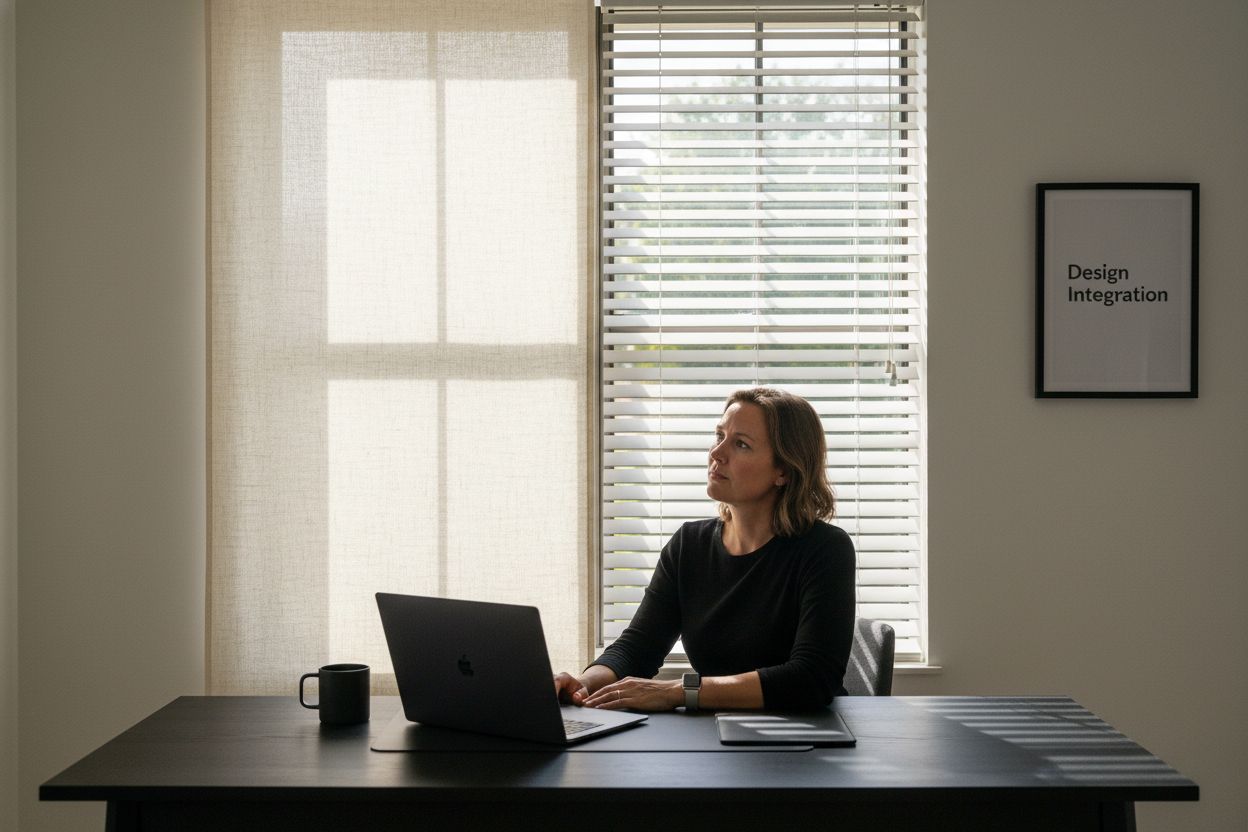
Material Choices and Customization Options
The world of window treatments offers a diverse landscape of materials and customization possibilities, enabling homeowners to create personalized solutions that perfectly match their interior design vision and functional requirements. Understanding the nuanced characteristics of different materials empowers consumers to make informed decisions.
Material Diversity and Performance
Energy efficiency experts recommend selecting window treatment materials based on their unique performance characteristics. Different materials deliver varying levels of light control, insulation, and durability. Roman shades and blinds present distinct material options that cater to specific aesthetic and practical needs.
Key material considerations include:
- Fabric weight and opacity for roman shades
- Moisture resistance for different environmental conditions
- Thermal insulation properties of various materials
- UV protection capabilities
Customization Potential
Customization transforms window treatments from basic coverings into personalized design elements. Roman shades offer extensive fabric and pattern possibilities, while blinds provide precision in material selection and operational mechanisms.
Customization options encompass:
- Color matching with existing interior color schemes
- Selecting specialized fabrics for specific functional requirements
- Choosing operational mechanisms like cordless or motorized systems
- Implementing decorative trims and unique folding styles
Explore sustainable window treatment options to understand how modern materials can align with environmental consciousness.
The intersection of material science and design innovation continues to expand the boundaries of window treatment possibilities. Homeowners now have unprecedented opportunities to select window coverings that are not just functional barriers, but integral components of their interior design narrative.
Elevate Your Light Control and Style Today
Struggling to balance elegant design with precise light control in your home? If you find the differences between roman shades and blinds confusing, you are not alone. Many homeowners want more than just a beautiful appearance. They need functional solutions for energy efficiency, privacy, and effortless maintenance—the same pain points discussed in your recent article. Discover our Trending Features for innovative window treatments that blend practical performance with modern style.
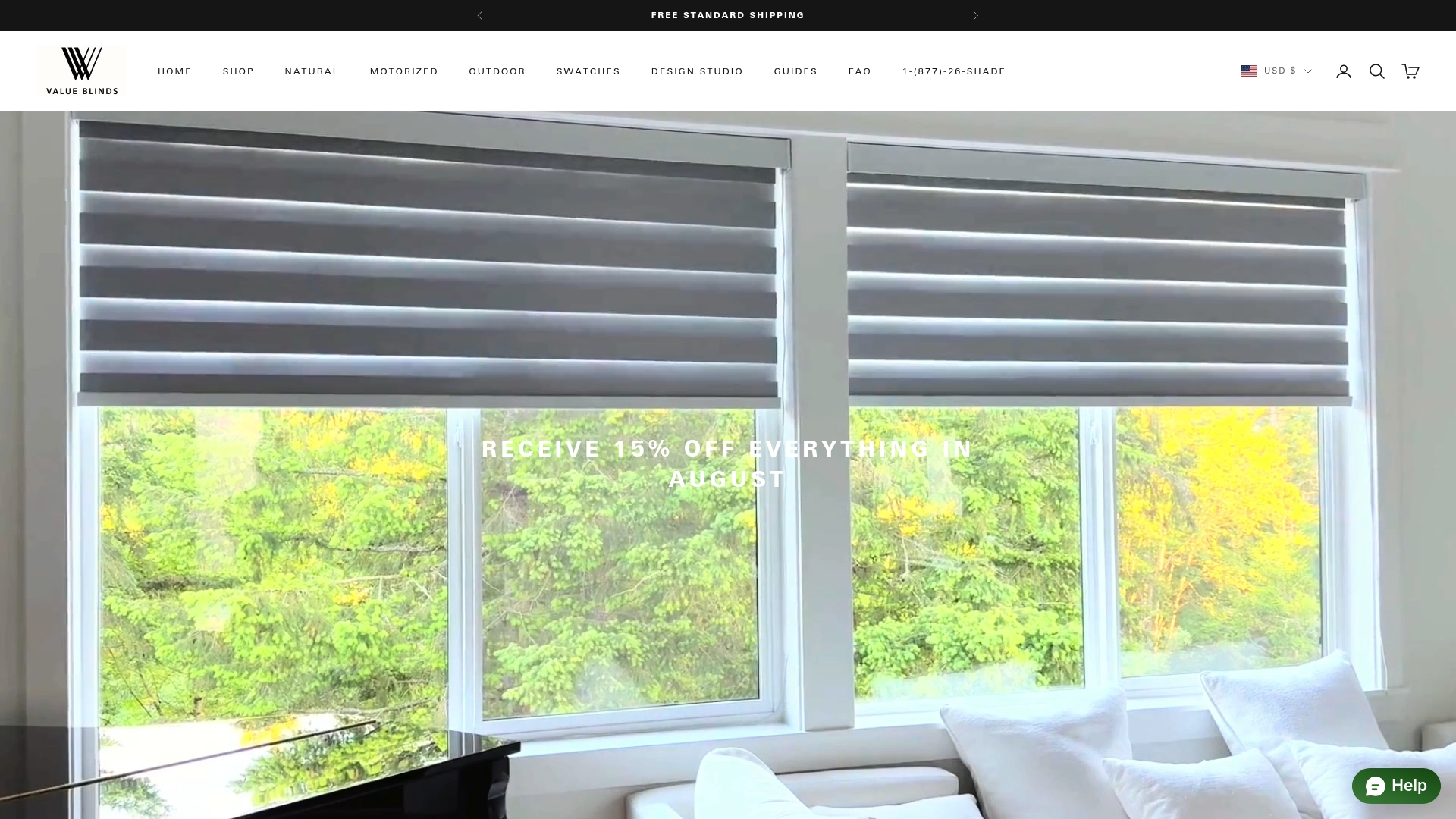
Now is the perfect time to upgrade your windows with options that solve both design and performance needs at once. Take the guesswork out of choosing between roman shades and blinds. Experience easy customization, free expert support, and durable materials at Value Blinds Direct. Explore our New Arrivals to find the latest styles built for your unique space. Transform your home’s comfort and beauty today.
Frequently Asked Questions
What are the main differences between roman shades and blinds?
Roman shades are made of fabric and fold into pleats when raised, offering a softer look. Blinds, made from materials like wood or aluminum, have slats that can be tilted for precise light control and a more structured appearance.
How do roman shades help with energy efficiency?
Roman shades provide excellent insulation due to their fabric construction, acting as a thermal barrier that helps regulate indoor temperatures, potentially reducing heating and cooling costs by up to 25%.
Are roman shades better for privacy than blinds?
Roman shades generally provide enhanced privacy because they create a continuous fabric surface that blocks the view from outside more effectively, whereas blinds can have gaps between slats, depending on their angle.
What factors should I consider when choosing between roman shades and blinds?
Consider your aesthetic preferences, light control needs, maintenance requirements, and the specific room environment. Each option has unique features that suit different design goals and functional demands.


